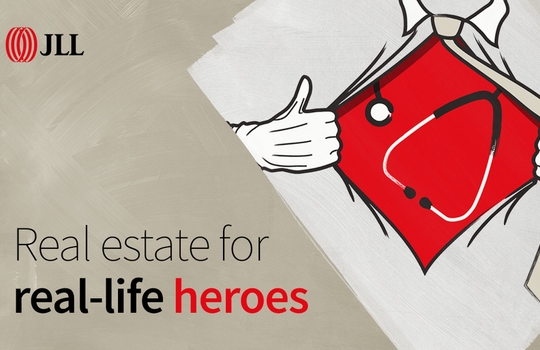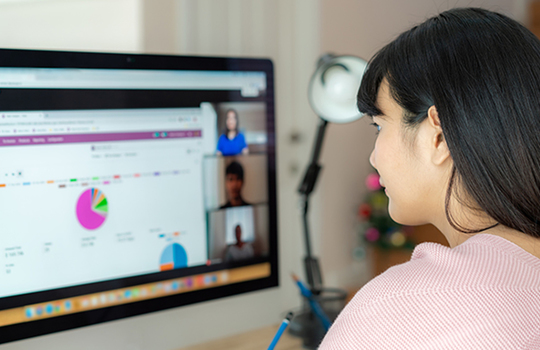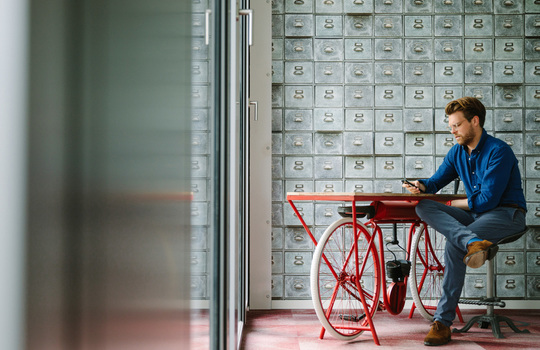Workplace preparedness during COVID-19 requires employers to provide the productivity tools and support employees need to be effective when working remotely.
Check the JLL Poland team experience of remote working, download our report "When home is a new office" and contact us to conduct a survey in your company.
Seemingly overnight, the coronavirus pandemic has expanded the boundaries of how far organizations thought flexible workplace policies could stretch. Even organizations with more traditional workplace cultures, such as utilities and universities, are directing staff to work remotely in an effort to keep employees healthy and slow the spread of the virus. And organizations that already had a substantial work-from-home population before the crisis are finding they need to quickly and unexpectedly expand their remote work program for what may be an extended time period.
For companies across all geographies and industries, workplace disruption might be inevitable. The companies who effectively manage that disruption will be well-positioned not only to maintain business operations throughout the outbreak, but better prepared for future crises, too. As employees pack up their laptops to work from remote locations, workplace strategists and corporate real estate leaders can play a key role in shaping productive, engaging workplace culture and behaviors wherever that work takes place.
Following are tips for ensuring employees have the tools and support they need to be productive, effective and connected while working remotely.
1. Prioritize health and wellness above all else
As COVID-19 spreads to an ever-growing segment of the global population, the top priority of every organization in this time of crisis should be on protecting the health of its talent, customers, vendors and other stakeholders. Countless organizations are demonstrating their commitment to slowing the spread of the virus by closing facilities (or parts of them), and deploying a remote working plan.
While sending employees to work in the self-contained bubbles of their homes keeps a large segment of workers safe, what about employees who cannot do their jobs remotely? Some organizations are quarantining mission-critical functional areas that must remain in operation, cordoning off physical spaces where those employees can do their jobs without coming into contact with other people. Some energy companies are even exploring the idea of having power plant operators sleep in the plant to minimize exposure to germs.
Such measures may seem extreme and will surely be disbanded when social distancing is no longer required, but one thing the pandemic has made it clear is just how important it is to pay attention to “building health” issues such as ventilation, air filtration, cleaning and facilities management preparedness. The desire to work in healthy buildings will not dissipate any time soon.
2. Build the right infrastructure for the virtual workplace
At its core, a virtual workplace includes many of the same elements as a physical one: places to collaborate, share ideas and get work done. Yet it can take a Herculean effort to ensure each employee has the basic technology to be effective in that virtual environment: laptops, a VPN, file sharing systems, access to essential software, a mobile phone and high speed WiFi at home.
In addition to this basic infrastructure, organizations will need to provide access to the right collaboration and communication tools to work together virtually. When we design workplaces, we often design neighborhoods so people who must collaborate sit in close proximity to each other. Now we must figure out how to recreate the neighborhood concept online. From internal chat and messenger apps to videoconferencing solutions, equipping employees with tools to communicate—and providing training on how to use them—can make all the difference between a connected organization and a collection of people working in silos.
It can be helpful to have a digital workplace manager or team to support people as they get set up to work remotely. A support team could include a workplace designer who provides the advice and tools needed to set up an ergonomic workstation at home, as well as a virtual help desk to help employees navigate the complexities of setting up their home systems.
3. Combat productivity/engagement pits with virtual cultural initiatives
In a new reality when even coffee shops and bars are closed down in many cities, working from home with little in-person interaction for even a few days can feel isolating for some people, which can diminish both productivity and engagement.
Organizations must make a proactive effort to combat these impacts, taking steps to ensure employees still feel connected even if they aren’t in close proximity. Virtual coffee talks, happy hours or book clubs, along with gaming and avatar-based socialization can go a long way toward achieving that goal. They may not be a perfect substitute for the carefully curated lounges, coffee bars and community events that a well-designed office experience provides, but they can help maintain a sense of community until life returns to normal.
As you think about how to reinforce organizational culture, it is important to acknowledge the variety of challenges employees will face during COVID-19 social distancing. A single, extroverted employee working alone from a small apartment may be feeling deep loneliness, while a working parent may be under intense pressure to care for small children or manage home schooling in the midst of their workday. As such, their desire/ability to participate in virtual cultural events may differ, but all employees can benefit from regular phone or video calls with their direct teams about work-related matters and digital collaboration tools that make it easier to work together.
4. Explore alternative work sites beyond home and the office
In some instances, employees will be unable to go into the corporate office as usual, but working from home isn’t an option—either because the nature of an individual’s role is too sensitive to be carried out in an unsecured location, they need access to equipment or programs that are inaccessible remotely, or because their home environment is not conducive to work.
That’s why some organizations are assessing alternative work sites, such as sterilized coworking centers. If you are considering such an option, it’s important to have a clear understanding of their sanitation processes and schedule, and who has access to the facility. Longer term, more organizations may see the value in identifying a network of alternative work sites where employees can be productive during emergency situations.
5. Treat communication as a two-way street
Clear communication is essential to provide transparency during these fast-changing times. Establish protocols and guidelines to communicate information to employees and business partners on your infectious disease outbreak response plans. An intranet site can serve as a way for employees to access any information they are seeking about COVID-19 workplace policies and updates.
Just as important, avoid miscommunication by ensuring the appropriate dissemination of information and avoiding “fake news” or “infodemics.” (An “infodemic” is an overabundance of information—some accurate and some not—that makes it hard for people to find trustworthy sources and reliable guidance when they need it.)
Recognize that employees will have many concerns about the impact not only to their workday, but also about the longer-term implications for the economy and their job. Communicate early and often about the impacts of the pandemic to your business and the expectations for employees during this period, and set up feedback channels for employees who have concerns and questions.
How will COVID-19 change the future of work?
It’s impossible to predict the long-term implications of today’s sudden, massive shift to remote work, but a few outcomes are possible. One is that employees and business leaders alike will open their eyes to the value that can be unlocked when each individual has the freedom to work where and when it makes most sense—which may be from home at least part of the time. Yet it’s just as likely that we will emerge from this period craving the face-to-face interaction that has been sorely missed, and with a greater understanding of how physical space influences the way we all feel and work each day. Workplace strategists and designers will have an ever-more important role to play in shaping the future of places and spaces where we can come together to connect, work productively and be inspired.
DISCLAIMER: JLL and our staff are not authorized or qualified to guide or influence you in the preparation of your own business continuity or preparations plans from a health and public policy perspective. While we are making efforts to ensure we are providing an up-to-date list of publicly available resources, all details on COVID-19, as well as health and public policy implications, should be addressed with the advice of an independent specialist.






